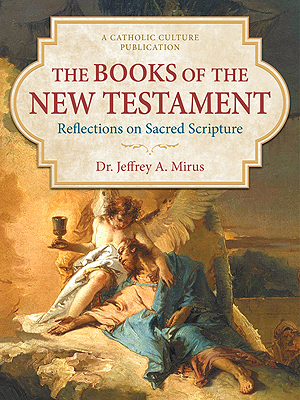Jesus of Nazareth: The Infancy Narratives
By Dr. Jeff Mirus ( bio - articles - email ) | Dec 06, 2012 | In Reviews
I've just read the third and final volume of the Pope's study of Jesus of Nazareth. This was originally projected as a separate monograph, in which the Pope applies his special brand of exegesis, which is really a profound renewal of exegesis, to the infancy narratives.
Free eBook:

|
| Free eBook: The Books of the New Testament |
Chronologically, of course, this would be the logical volume with which to start reading these three books. And because this volume is substantially shorter (less than half the length of the previous two volumes), it would also be an excellent place to start for anyone who wants to sample what the Pope has to offer before deciding whether to read the entire study.
I think the best way to introduce the potential reader to what the Pope is doing here is simply to extract one passage, taken almost at random in terms of its wisdom, but particularly well-suited to our Advent preparation for Christmas. This is how Benedict describes the manger as presented in the Gospel accounts (pp. 68-9):
* * * * *
Mary wrapped the child in swaddling cloths. Without yielding to sentimentality, we may imagine with what great love Mary approached her hour and prepared for the birth of her child. Iconographic tradition has theologically interpreted the manger and the swaddling cloths in terms of the theology of the Fathers. The child stiffly wrapped in bandages is seen as prefiguring the hour of his death: from the outset, he is the sacrificial victim, as we shall see more closely when we examine the reference to the first-born. The manger, then, was seen as a kind of altar.
Augustine drew out the meaning of the manger using an idea that at first seems almost shocking, but on closer examination contains a profound truth. The manger is the place where animals find their food. But now, lying in the manger, is he who called himself the true bread come down from heaven, the true nourishment that we need in order to be fully ourselves. This is the food that gives us true life, eternal life. Thus the manger becomes a reference to the table of God, to which we are invited so as to receive the bread of God. From the poverty of Jesus' birth emerges the miracle in which man's redemption is mysteriously accomplished.
The manger, as we have seen, indicates animals, who come to it for their food. In the Gospel there is no reference to animals at this point. But prayerful reflection, reading Old and New Testaments in the light of one another, filled this lacuna at a very early stage by pointing to Is 1:3: “The ox knows its owner, and the ass its master's crib; but Israel does not know, my people does not understand.”
Peter Stuhlmacher points out that the Greek version of Hab 3:2 may well have contributed here: “In the midst of two living creatures you will be recognized ... when the time has come, you will appear” (cf. Die Geburt des Immanuel, p. 52). The two living creatures would appear to refer to the two cherubs on the mercy-seat of the Ark of the Covenant (cf. Ex 25:18-20), who both reveal and conceal the mysterious presence of God. So the manger has in some sense become the Ark of the Covenant, in which God is mysteriously hidden among men, and before which the time has come for “ox and ass”—humanity made up of Jews and Gentiles—to acknowledge God.
Through this remarkable combination of Is 1:3, Hab 3:2, Ex 25:18-20 and the manger, the two animals now appear as an image of a hitherto blind humanity which now, before the child, before God's humble self-manifestation in the stable, has learned to recognize him, and in the lowliness of his birth receives the revelation that now teaches all people to see. Christian iconography adopted this motif at an early stage. No representation of the crib is complete without the ox and the ass.
* * * * *
I've already reviewed and commented on the first two volumes of Jesus of Nazareth. Here is the list of prior essays:
- Benedict's New Book
- The “Our Father” according to Benedict
- A Final Note on Benedict's Jesus of Nazareth
- Benedict's Second Volume and the Historical Critical Method
- Ratzinger's Gift: Faith-Filled Exegesis
As always, you can purchase these three volumes through our Amazon affiliation, in which case roughly eight percent of the price will go to CatholicCulture.org.
All comments are moderated. To lighten our editing burden, only current donors are allowed to Sound Off. If you are a current donor, log in to see the comment form; otherwise please support our work, and Sound Off!








